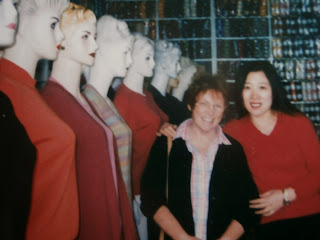Quite soon after we arrived in Tonghua Katharine and I met eighteen year old student Helen, who lived in term time in the city of Changchun but was spending the Summer break at the family home. She could hardly believe her luck at meeting two English-speakers in her home town and appointed herself as our guide as well as introducing us to her family.
Helen’s
mother ran a wool shop in the main street, above a handbag emporium, where she was
surrounded by ceiling-high shelves and counters full of knitting wool. It took
a while for our eyes to adjust to the gloom, the light filtering through a narrow
grimy window at the end facing the street.
A dozen or so alabaster mannequins were standing in front of the window, ghostly white in the dimness, their faces having distinctly western features. They seemed to date from the nineteen forties, judging by their upswept, victory roll, plaster hair-styles. Those not grouped by the window made up a double row down the centre of the room. They gave the sweaters and cardigans they modelled an air of unintended lewdness, as few of the models had skirts or trousers.
A dozen or so alabaster mannequins were standing in front of the window, ghostly white in the dimness, their faces having distinctly western features. They seemed to date from the nineteen forties, judging by their upswept, victory roll, plaster hair-styles. Those not grouped by the window made up a double row down the centre of the room. They gave the sweaters and cardigans they modelled an air of unintended lewdness, as few of the models had skirts or trousers.
The
assistants in the downstairs shop had called out ‘Huanying! Huanying!’ in
welcome, and congratulated Helen, who insisted we use her ‘English’ name, on
having brought in two foreigners.
Helen’s mother, who looked about 30, a vivacious, slender woman in tight-fitting clothes, with red lip-stick and quick movements, looked more like the hostess of aShanghai
Helen’s mother, who looked about 30, a vivacious, slender woman in tight-fitting clothes, with red lip-stick and quick movements, looked more like the hostess of a
She brought
us a couple of stools so we could rest a while and looked on as Helen became
quite agitated with the excitement of having us in the shop, waving her arms
about and repeating, ‘Oh, I am so sorry, but my English is so poor’ She had
already told us they lived on the premises; towards the back of the room there
was a small partitioned area with a double bed, a TV and a dressing table. The
parents owned the whole building, she said, and let off the ground floor and an
upper floor to other businesses. This was the slack summer season for her
business, but with the first snows, in October, she would move downstairs.

At one point, the character 春草 in《春草》opened a shop selling silk products from her village, and the arrangement is exactly like in your blog story (shop out front, living area at the back): https://www.youtube.com/watch?v=1cFHGHIaWeM&t=133s
ReplyDelete